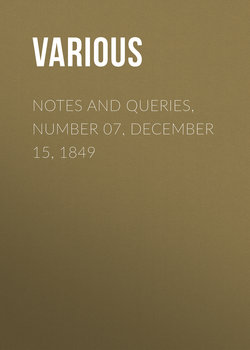Читать книгу Notes and Queries, Number 07, December 15, 1849 - Various - Страница 4
MONETA SANCTÆ HELENÆ
ОглавлениеAs a subscriber to your valuable publication, allow me to suggest that it might, from time to time, be open to contributions explaining obscure passages or words, which often occur in the works of mediæval writers, and more especially in early English records. So far as English usages and customs are concerned, the Glossary of Du Cange is of comparatively little value to the English student; many terms, indeed, being wrongly interpreted in all editions of that work. Take, for example, the word "tricesima," the explanation of which is truly ridiculous; under "berefellarii," the commentary is positively comic; and many other instances might be cited. At the same time, it would be presumptuous to speak otherwise than in terms of the highest respect and admiration of Du Cange and his labours. The errors to which I allude were the natural consequences of a foreigner's imperfect knowledge of English law and English customs; still it is to be lamented that they should have remained uncorrected in the later editions of the Glossary; and I take it to be our duty to collect and publish, where feasible, materials for an English dictionary of mediæval Latin. It is in your power materially to advance such a work, and under that impression I venture to send the present "Note."
In the Wardrobe Account of the 55th year of Henry the Third, it is stated that among the valuables in the charge of the keeper of the royal wardrobe, there was a silken purse, containing "monetam Sancte Helene." It is well known that, during the middle ages, many and various objects were supposed to possess talismanic virtues. Of this class were the coins attributed to the mother of Constantine, the authenticity of which is questioned by Du Cange, in his treatise "de Inferioris ævi numismatibus." He observes, also, that the same name was given, vulgarly, to almost all the coins of the Byzantine emperors, not only to those bearing the effigies of St. Helena, but indeed to all marked with a cross, which were commonly worn suspended from the neck as phylacteries; "hence," he subjoins, "we find that these coins are generally perforated." It was quite in accordance with the superstitious character of Henry the Third that coins of St. Helena should be preserved in his wardrobe, among numerous other amulets and relics. But what was the peculiar virtue attributed to such coins? Du Cange, in the same treatise, says, on the authority of "Bosius," that they were a remedy against the "comitialem morbum," or epilepsy. The said "Bosius," or rather "Bozius," wrote a ponderous work, "de Signis Ecclesiæ Dei" (a copy of which, by the by, is not to be seen in the library of the British Museum, although there are two editions of it in the Bodleian), in which he discourseth as follows:—"Monetæ adhuc aliquot exstant, quæ in honorem Helenæ Augustæ, et inventæ crucis, cum hujusmodi imaginibus excusæ antiquitus fuerunt. Illis est præsens remedium adversus morbum comitialem: et qui hodie vivit Turcarum Rex Amurathes, quamvis a nobis alienus, vim sanctam illarum expertus solet eas gestare; e morbo namque hujusmodi interdum laborat. Nummi quoque Sancti Ludovici Francorum regis mirifice valent adversus nonnullos morbos."—Lib. xv. sig. 68.
This mention of the sultan Amurath carrying these coins about his person as a precaution against a disease to which he was subject, and indeed the whole passage shows a belief in their efficacy was still prevalent in the sixteenth century, when Bozius wrote. It only remains to add, that Du Cange, in his Glossary, does not enumerate the "money of St. Helena" under the word "moneta;" nor does he allude to the coins of St. Louis, which, according to Bozius, were endowed with similar properties.
Having sent you a "Note," permit me to make two or three "Queries." 1. What is the earliest known instance of the use of a beaver hat in England? 2. What is the precise meaning of the term "pisan," so often used, in old records, for some part of defensive armour, particularly in the thirteenth and fourteenth centuries? It does not bear any relation to the fabrics of Pisa.
T. HUDSON TURNER.
